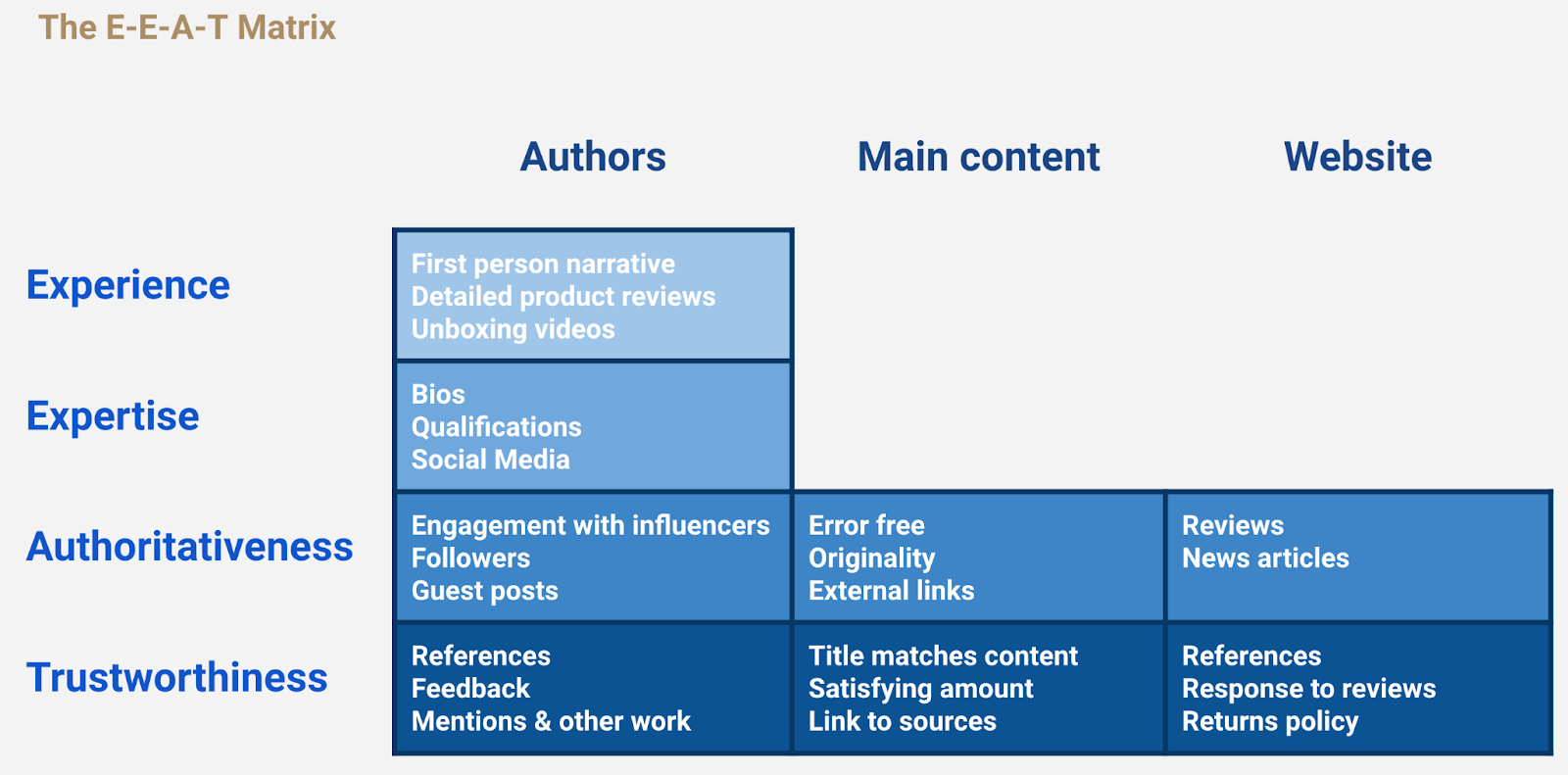Decoding E-E-A-T: From YMYL to SGE, the ultimate guide for ecommerce success
06 Oct 2023|5 MIN READ
In the ever-evolving world of SEO, Google's E-A-T (Expertise, Authoritativeness, Trustworthiness) has long been the gold standard for assessing website quality. But as of December 2022, the game has changed.
Enter Google E-E-A-T, where the additional 'E' signifies Experience. This pivotal update amplifies the role of first-hand experience in content evaluation, setting a new benchmark for quality and relevance.
Why experience matters now more than ever?
The introduction of ‘Experience’ into Google’s Quality Raters Guidelines comes at a crucial juncture – amidst the rise of AI-generated content. This strategic move aims to ensure that the content surfacing in search engines not only matches user intent but also aids in making well-informed decisions. In essence, it elevates the value of content crafted or reviewed by individuals who possess tangible, real-world experience on the subject matter.
Trust: The cornerstone of E-E-A-T in the AI era
In this new framework, Trust emerges as the most vital part of E-E-A-T. Google’s stance is unequivocal: “Untrustworthy pages will score low on E-E-A-T, irrespective of their Experience, Expertise, or Authoritativeness.”
What is Google E-E-A-T?
Before diving into the intricacies of E-E-A-T, it’s essential to understand what each letter in this acronym stands for:
Experience
The latest addition to the E-A-T acronym, ‘Experience’ emphasises the importance of first-hand knowledge or life experience related to the topic a page covers. Whether it’s a product review by someone who has actually used the product or an article on health by someone who has lived through a specific condition, Google values this experiential insight.
Expertise
This refers to the level of knowledge or skill in a particular area. Google looks for content created by experts in the field. For instance, medical advice should come from healthcare professionals, and financial advice should be provided by certified financial planners.
Authoritativeness
This is about the credibility and reliability of the website and the content. Authoritativeness is often gauged by the site’s reputation, the reputation of the offering, the quality of backlinks it has, and how well it covers the topic at hand.
Trustworthiness
This aspect focuses on how trustworthy the site is, which is crucial for YMYL (Your Money or Your Life – see detailed explanation below) topics. Elements like secure connection (HTTPS), transparent information about the website’s owners, and verifiable facts contribute to a site’s trustworthiness.
Together, these four components create a comprehensive framework that Google uses to assess the quality of web pages. High E-E-A-T scores are often associated with higher search rankings, making it a critical focus for SEO strategies, especially for websites dealing with YMYL topics.
The relationship between YMYL and E-E-A-T
Your Money or Your Life (YMYL) pages are those that could potentially impact a person’s future health, wealth or wellbeing. Google holds these pages to the highest quality standards, and that’s where E-E-A-T comes into play. Demonstrating high levels of E-E-A-T is crucial for YMYL pages to gain favourable rankings. The addition of ‘Experience’ to E-E-A-T further intensifies this relationship, making it imperative for YMYL pages to not just be authoritative and trustworthy, but also deeply rooted in real-world experience.
So, how does Google E-E-A-T measures the Experience, Expertise, Authoritativeness and Trustworthiness of your website?
Well, firstly it breaks the analysis down into three dimensions, to analyse:
- The quality of your website
- The quality of the main content on any page
- And the quality of the author(s) of the main content
Please note that Experience and Expertise only applies to the Author of the main content.

How to effectively demonstrate Google E-E-A-T signals in E-commerce?
Experience
Experience stems from Google’s Review Update which aims to better reward high quality reviews, which is content that provides insightful analysis and original research and is written by experts or enthusiasts who know the topic well.
Google says: “Does content also demonstrate that it was produced with some degree of experience, such as with actual use of a product, having actually visited a place, or communicating what a person experienced?”
“Provide evidence such as visuals, audio, or other links of your own experience with the product, to support your expertise and reinforce the authenticity of your review.”
Here are some tips to demonstrate first-hand product Experience:
First person narrative
Content creators should adopt a first-person narrative to showcase first-hand experience with products. This not only lends authenticity but also aligns seamlessly with Google’s E-E-A-T criteria, particularly emphasising ‘Experience.’ To validate why a product is deemed the “best,” creators should articulate their evaluation process, touching on aspects like quality, functionality, and customer feedback. Offering a nuanced breakdown of each product’s Pros and Cons is essential for empowering readers to make informed decisions. This approach satisfies Google’s E-E-A-T guidelines, Reviews Update System and Helpful Content System, elevating the content’s value and trustworthiness.
User-Generated Content
Encourage customers to share their own experiences with your products. This could be through reviews, photos, or social media mentions. This not only adds credibility but also enriches the content on your site.
Social Proof
Showcase awards, certifications, and partnerships that can vouch for your business’s credibility and experience in the industry.
Regular Updates
Keep your content fresh and up-to-date. Show that it’s been reviewed recently to maintain a high level of trust.
Expertise
To show Google that the author satisfies the “Expertise” criteria in E-E-A-T, it’s essential to take a multi-faceted approach that goes beyond just stating qualifications. Here are some effective strategies:
- Detailed Author Bio: Include a comprehensive author bio on every article or blog post. This should outline the author’s qualifications, experience, and any relevant certifications.
- Credentials: If the author has any professional certifications, degrees, or affiliations, make sure to mention them explicitly.
- External Contributions: If the author has been published in reputable journals, magazines, or other authoritative websites, link to those publications.
- Awards and Recognitions: Highlight any awards or recognitions the author has received in the field.
- Social Proof/Testimonials: Include testimonials from other experts in the field or satisfied customers who can vouch for the author’s expertise.
- Social Media: Leverage professional social media profiles like LinkedIn to showcase the author’s expertise and endorsements.
Authority
To establish your website and its main content as authoritative in Google’s eyes, you’ll need to focus on several key areas that collectively contribute to a strong perception of authority. Here’s how to go about it:
- High-Quality Inbound Links: Secure backlinks from reputable websites in your industry. The quality of the sites linking to you can significantly boost your site’s authority.
- Anchor Text: Ensure that the anchor text used in backlinks is relevant to your content and not overly optimised for keywords.
- Comprehensive Coverage: Your content should offer in-depth analysis and cover all aspects of the topic at hand.
- Expert Contributions: Feature guest posts, interviews, or quotes from recognized experts in your field.
- Social Shares: Encourage and track social media shares of your content. High levels of engagement often correlate with authority.
- User Comments: A healthy number of positive and insightful user comments can indicate that your content is considered authoritative.
- Internal Linking: Use strategic internal linking to guide users to other relevant authoritative content on your site.
- Regular Updates: Consistently publish high-quality content to maintain and build your site’s authority over time.
Trust
Establishing trustworthiness is a critical component of Google’s E-E-A-T framework. To ensure that both your main content and website are perceived as trustworthy, focus on the following key areas:
Security Measures
- SSL Certificate: Implement HTTPS to secure your site. Google considers HTTPS as a strong signal of trustworthiness.
- Privacy Policy: Clearly outline how user data will be used and protected. Make this easily accessible from every page on your site.
Transparency
- About Us Page: Provide detailed information about your business, including its history, mission, and team members.
- Contact Information: Display multiple ways for visitors to contact you, such as email, phone number, and physical address, if applicable.
Content Accuracy and Credibility
- Fact-Checking: Ensure all claims, statistics, and data are accurate and up-to-date. Cite reputable sources to back up your information.
- Author Credentials: Include author bios that highlight their expertise and qualifications, especially for content that falls under YMYL categories.
User Experience
- Ease of Navigation: Make sure your website is easy to navigate, with a clean design and intuitive menu structure.
- Page Load Speed: Optimise your site for speed. A slow-loading site can erode user trust.
User Engagement and Reviews
- User Testimonials: Feature testimonials from satisfied customers or clients. Use schema markup to highlight these on your site.
- Third-Party Reviews: Positive reviews on external platforms like Google My Business or Trustpilot can significantly boost your site’s trustworthiness.
Social Proof
- Social Media Presence: Maintain active and professional social media profiles. Regularly engage with your audience and share valuable content.
- Industry Affiliations: Display any memberships, certifications, or affiliations with reputable industry organisations.
Legal Compliance
- Terms and Conditions: Clearly outline the terms and conditions for using your website and/or purchasing your products/services.
- Compliance Badges: If you’re in a regulated industry, display any required compliance badges or certifications.
Financial Transactions
- Secure Payment Gateways: Use trusted and secure payment gateways for any financial transactions.
- Money-Back Guarantee: Offering a money-back guarantee can enhance trust, especially for ecommerce sites.
The relationship between Schema Markup and E-E-A-T
Schema markup plays a pivotal role in helping search engines understand the context and quality of your website’s content. When it comes to E-E-A-T, schema can be a powerful tool for sending the right signals to Google. Here’s how:
Showcasing experience
UserGeneratedContent Schema: For content like testimonials or user reviews that demonstrate first-hand experience, you can use the UserGeneratedContent schema.
HowTo Schema: For instructional content, the HowTo schema can help showcase the practical application of expertise, thereby demonstrating experience. (Google recently announced it would be reducing the visibility of FAQ rich results, and limiting How-To rich results to desktop devices – however other search engines can still use it)
Demonstrating expertise
Author Schema: Use the Person schema to mark-up author bios, including their qualifications, affiliations, and social media profiles. This helps Google understand the level of expertise behind the content.
Educational and Professional Credentials: Utilise schema properties like alumniOf, award, and hasCredential to highlight the author’s qualifications.
Establishing authoritativeness
Organisation Schema: Implement the Organisation schema to provide structured information about your business, including its founding date, location, and industry awards.
SameAs Attribute: Use the sameAs property to link to your organisation’s or author’s profiles on reputable platforms, thereby establishing authority.
Enhancing trustworthiness
Review Schema: If your site has customer reviews, use the Review schema to highlight these. Positive reviews can significantly boost your site’s trustworthiness.
AggregateRating Schema: For products or services with multiple reviews, the AggregateRating schema can summarise the overall rating, providing a quick trust signal.
Additional trust signals
FAQ Schema: For FAQ pages, the FAQPage schema can help Google understand that you’re providing authoritative and helpful answers to common questions. (Google recently announced it would be reducing the visibility of FAQ rich results, and limiting How-To rich results to desktop devices – however other search engines can still use it)
Breadcrumb Schema: This helps Google understand the navigational hierarchy of your site, which can be a subtle trust signal.
By strategically implementing these schema types and properties, you can effectively communicate your website’s E-E-A-T attributes to Google. This not only helps in enhancing your site’s search visibility but also contributes to building a strong E-E-A-T profile, which is increasingly important in Google’s ranking algorithms.
Is Google E-E-A-T a Ranking Factor?
While E-E-A-T is not directly a ranking factor in Google’s algorithm, it’s a significant component of Google’s Search Quality Rater Guidelines. These guidelines are used by human raters to evaluate web pages, and their feedback indirectly influences the algorithm. Therefore, high E-E-A-T can contribute to better search rankings, especially for YMYL pages.
Navigating E-E-A-T and SGE
I can’t end this post without addressing the importance of E-E-A-T when navigating the intricacies of the Generative AI landscape, particularly concerning SGE.
Google’s Search Generative Experience (SGE) aims to deliver the most relevant, high-quality search results to users by leveraging advanced algorithms and machine learning techniques. At the core of SGE are “quality signals”, which help Google determine the value a webpage offers to users. E-E-A-T serves as one of the most critical frameworks for these quality signals.
Here’s how the two are intrinsically linked:
Relevance and expertise
SGE focuses on understanding the user’s intent and delivering the most relevant results. E-E-A-T contributes to this by emphasising the “Expertise” of the content. Content created by experts is more likely to be accurate, insightful, and relevant to the user’s query, thereby aligning with SGE’s goals.
User experience and experience
The “Experience” in E-E-A-T and the user experience in SGE are closely related. Both aim to provide the user with a seamless, informative, and satisfying experience. Whether it’s page load speed, mobile-friendliness, or the depth of content, these factors contribute to both a positive user experience and higher E-E-A-T scores.
Credibility and authoritativeness
SGE uses quality signals to gauge the credibility of a webpage. E-E-A-T’s “Authoritativeness” serves as a key indicator here. Factors like quality backlinks, citations from reputable sources, and a strong online reputation all contribute to a site’s authority, which SGE algorithms can recognize and reward.
Trust signals and trustworthiness
SGE is designed to filter out low-quality or deceptive content. The “Trustworthiness” aspect of E-E-A-T plays a crucial role in this. Secure websites (HTTPS), transparent business practices, and positive user reviews are trust signals that both E-E-A-T and SGE value highly.
Algorithmic interpretation
While E-E-A-T provides a framework for human raters to evaluate webpages, SGE’s machine learning algorithms are trained to interpret similar quality signals algorithmically. Over time, as SGE becomes more sophisticated, its alignment with E-E-A-T criteria is likely to become even more nuanced and precise.
Adaptability and Core Updates
Both E-E-A-T and SGE are dynamic and adapt to the evolving landscape of online content and user behaviour. Google’s Core Updates often bring changes that affect how E-E-A-T and quality signals are interpreted, making it essential for websites to stay updated with both.
In summary, E-E-A-T serves as a foundational framework for the quality signals that SGE relies on. Understanding and optimising for E-E-A-T is not just about complying with Google’s Search Quality Rater Guidelines; it’s about aligning your website with the broader objectives of Google’s Search Generative Experience.
E-E-A-T has evolved into a pivotal framework for Google’s quality assessment, especially with the addition of ‘Experience’. For luxury e-commerce companies, aligning with E-E-A-T is not just about SEO; it’s about future-proofing your brand in the era of Google’s Search Generative Experience (SGE). By leveraging schema markup to amplify E-E-A-T signals and placing a renewed emphasis on user experience, you’re not only optimising for today’s search algorithms but also building a brand that resonates with quality and trust, creating a win-win situation for both search rankings and customer loyalty.
If you’d like to learn more and see how Pi’s Search Intelligence Platform can help you align with E-E-A-T – get in touch with the team.
Demo the software today
Never miss a post
Join our mailing list and have our SEO news delivered straight to your inbox.
Never miss a post
Join our mailing list and have our SEO news delivered straight to your inbox.





